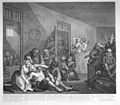The Cartoon Portal

A cartoon is a type of visual art that is typically drawn, frequently animated, in an unrealistic or semi-realistic style. The specific meaning has evolved, but the modern usage usually refers to either: an image or series of images intended for satire, caricature, or humor; or a motion picture that relies on a sequence of illustrations for its animation. Someone who creates cartoons in the first sense is called a cartoonist, and in the second sense they are usually called an animator.
The concept originated in the Middle Ages, and first described a preparatory drawing for a piece of art, such as a painting, fresco, tapestry, or stained glass window. In the 19th century, beginning in Punch magazine in 1843, cartoon came to refer – ironically at first – to humorous artworks in magazines and newspapers. Then it also was used for political cartoons and comic strips. When the medium developed, in the early 20th century, it began to refer to animated films that resembled print cartoons. (Full article...)

In print media, a cartoon is a drawing or series of drawings, usually humorous in intent. This usage dates from 1843, when Punch magazine applied the term to satirical drawings in its pages,[1] particularly sketches by John Leech.[2] The first of these parodied the preparatory cartoons for grand historical frescoes in the then-new Palace of Westminster in London.[3]

Sir John Tenniel—illustrator of Alice's Adventures in Wonderland—joined Punch in 1850, and over 50 years contributed over two thousand cartoons.[4]
Selected article -
Calvin and Hobbes is a comic strip written and illustrated by Bill Watterson, following the humorous antics of Calvin, an imaginative six-year old boy, and Hobbes, his energetic and sardonic—albeit stuffed—tiger. The pair are named after John Calvin, a 16th century French Reformation theologian, and Thomas Hobbes, a 17th century English political philosopher. The strip was syndicated daily from November 18, 1985 to December 31, 1995. At its height, Calvin and Hobbes was carried by over 2,400 newspapers worldwide. To date, more than 30 million copies of the 18 Calvin and Hobbes books have been printed. The strip is vaguely set in the contemporary Midwestern United States, on the outskirts of suburbia, a location probably inspired by Watterson's home town of Chagrin Falls, Ohio. Calvin and Hobbes appear in most of the strips, while a small number focus on other supporting characters. The broad themes of the strip deal with Calvin's flights of fantasy, his friendship with Hobbes, his misadventures, his views on a diverse range of political and cultural issues and his relationships and interactions with his parents, classmates, educators, and other members of society. The dual nature of Hobbes is also a recurring motif. Calvin sees Hobbes one way (alive), while other characters see him as something else (a stuffed animal).
Selected character -
SpongeBob SquarePants is a fictional character in the animated television series SpongeBob SquarePants. He is voiced by Tom Kenny (pictured) and first appeared on television in the series' pilot episode "Help Wanted" on May 1, 1999. SpongeBob was created and designed by cartoonist Stephen Hillenburg shortly after the cancellation of Rocko's Modern Life in 1996. Hillenburg compared the concept to Laurel and Hardy and Pee-wee Herman. As he drew the character, he decided that a "squeaky-clean square" (like a kitchen sponge) fits the concept. His name is derived from "Bob the Sponge", the host of Hillenburg's comic strip The Intertidal Zone that he originally drew in 1989 while studying at the California Institute of Arts. SpongeBob is a naïve and goofy sea sponge who works as a fry cook in the fictional underwater town of Bikini Bottom. SpongeBob has achieved popularity with both children and adults, though he has been involved in public controversy.
Did you know... -
- ...that the film Green Lantern starring Ryan Reynolds has been in development since the 1990s and once included a comedic incarnation with Jack Black set to star?
- ...that Czechoslovak communist censors banned publishing of the comic album Muriel a andělé?
- ...that Uri-On, created by Michael Netzer in 1987, was the first Israeli superhero to be published in color?
- ...that Ed, Edd n Eddy's TV movie series finale, Ed, Edd n Eddy's Big Picture Show, premiered on November 8, 2009, and achieved high ratings success for Cartoon Network?
Selected list -
The Primetime Emmy Award for Outstanding Voice-Over Performance is a creative arts Emmy Award given out by the Academy of Television Arts and Sciences. It is awarded to a performer for an outstanding "continuing or single voice-over performance in a series or a special." Prior to 1992, voice-actors could be nominated for their performance in the live action acting categories. The award was first given in 1992 when six voice actors from The Simpsons shared the award. From 1992 to 2008, it was a juried award, so there were no nominations and there would be multiple or no recipients in one year. In 2009, the rules were changed to a category award, with five nominees. No winner was named in 1996 or 2007. Nine voice actors from The Simpsons have won a combined 14 Emmys. Of those, Dan Castellaneta has won four and Hank Azaria has won three. Ja'net Dubois won two for The PJs and Keith David won two for his narration of various documentaries. Voice actors from shows on Fox have won 17 of 27 awards.
General images -
Selected biography -
Lat is a Malaysian cartoonist whose work earned him the honorific title of datuk. He was born on 5 March 1951 in a village in Perak, Malaysia, and started supplementing his family's income at the age of nine by submitting his comics to magazines and newspapers. Four years later, he published his first comic book. In 1970, Lat left school and became a crime reporter while continuing his cartooning sideline. His comic about the Bersunat—a circumcision ceremony all Malaysian boys of the Islamic faith have to undergo—made a great impression on his newspaper's editor-in-chief. As a result, Lat became an editorial cartoonist. As he gained popularity through his cartoons in Malaysia, he published his autobiography in the form of two graphic novels—The Kampung Boy and Town Boy. The Kampung Boy was a huge success and gained him international renown. It is published in various countries around the world in several languages. Lat's cartoons provide an unbiased and humorous insight on the lives and culture of Malaysians, who consider him one of their most trustworthy citizens. His admirers include American cartoonists Sergio Aragonés and Matt Groening.
Subcategories

WikiProjects
- Main projects
- Arts • Animation • Comics • Entertainment • Visual arts
- Related Projects
- Anime and manga • Biography • Film • Fictional characters • Media franchises • Music • Television • Video games
Selected quote -
Topics
- Comic book
- Comic strip
- Digital comics
- Graphic novel
- Mobile comic
- Motion comics
- Trade paperback
- Webcomic
- Animator
- Animation director
- Animation studios
- Animation film festivals
- Feature-length films
- Short films
- Television series
- Computer-animated films
- Stop-motion films
- Traditional animation
- Limited animation
- Rotoscoping
- Stop Motion
- Clay
- Cutout
- Graphic
- Model
- Object
- Pixilation
- Puppetoon
- Computer animation
- Flash animation
- PowerPoint animation
- SVG animation
- Cel-shaded animation
- Crowd simulation
- Morph target animation
- Motion capture
- Non-photorealistic rendering
- Skeletal animation
Things you can do

- Requested articles: Fenwick (comics), Khimaera (comics), Mutant Underground Support Engine, Bruce J. Hawker, Marc Dacier, Hultrasson, Frankenstein Comics, Dave Johnson (comics), Paco Medina, Dappere Dodo, New Adventures of the Space Explorers, Habatales, Musical Box, Foo-Foo (TV series), Bonne nuit les petits, The Adventures of Lariat Sam, More...
- Images and photos needed: Request images that are needed from Wikipedia requested images of comics and animation to included in each articles.
- Stubs: Work on stubs in articles in Comics and Animation stubs.
- Infobox: Add infobox that are needed from Category:Comics articles without infoboxes and Category:Animation articles needing infoboxes in articles.
- Deletion sorting: Please see the collection of discussions on the deletion of articles related to comics and animation - compiled by WikiProject Deletion sorting
Related portals
Associated Wikimedia
The following Wikimedia Foundation sister projects provide more on this subject:
-
Commons
Free media repository -
Wikibooks
Free textbooks and manuals -
Wikidata
Free knowledge base -
Wikinews
Free-content news -
Wikiquote
Collection of quotations -
Wikisource
Free-content library -
Wikiversity
Free learning tools -
Wiktionary
Dictionary and thesaurus
More portals
Sources
- ^ Punch.co.uk. "History of the Cartoon". Archived from the original on 2007-11-11. Retrieved 2007-11-01.
- ^ Adler & Hill 2008, p. 30.
- ^ "Substance and Shadow: Original Editorial Accompanying "Cartoon, No. I"". Victorian web.org. Retrieved 29 October 2023.
- ^ "Sir John Tenniel". National Portrait Gallery. Retrieved 26 August 2022.









































